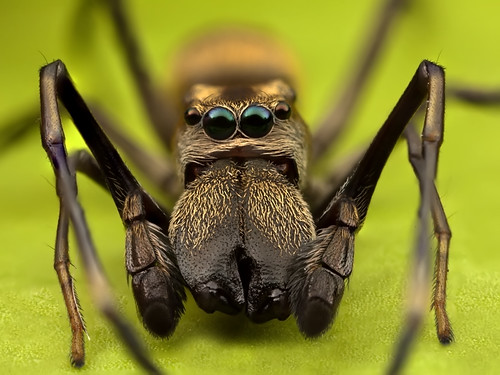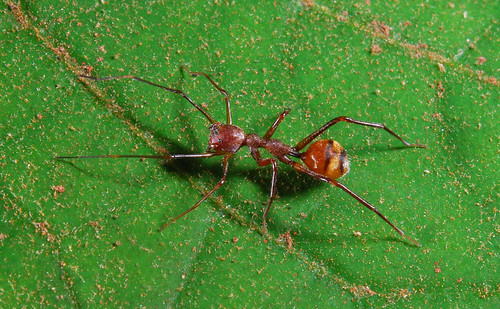Happy spider collecting!
A Blog about jumping spiders for all those who are curious, afraid or just plain interested in these fascinating little predators.
07 July 2014
How to catch a Jumping spider!
Greetings fellow spider enthusiasts! Just a quick post for you today as I happened to stumble across a video that was entirely too good not to share. The video below is a primer on how to catch salticids in the wild. The video features Dr. Wayne Maddison, one of the world's foremost experts on salticids. Please take a few minutes and watch this highly informative video, as I can virtually guarantee that you will learn something new, I know I did! Also, if you'd prefer to watch it in a new window, just click the link below the video.
03 July 2014
Visiting blog post
Hi guys,
I know I've been super quite of late, and I apologize for that. However, I do have a guest blog posting over at http://www.wildlensinc.org/blog/ that you should all totally check out! The blog is run by a good group of conservationists and I'm sure they would appreciate your taking the time to peruse their work.
Also just FYI, this blog will be quite for a little longer yet as I am finishing up my dissertation and it is eating all of my time currently. Expect a new post around the last week in August (my turn in date), if not sooner!
Happy spidering!
I know I've been super quite of late, and I apologize for that. However, I do have a guest blog posting over at http://www.wildlensinc.org/blog/ that you should all totally check out! The blog is run by a good group of conservationists and I'm sure they would appreciate your taking the time to peruse their work.
Also just FYI, this blog will be quite for a little longer yet as I am finishing up my dissertation and it is eating all of my time currently. Expect a new post around the last week in August (my turn in date), if not sooner!
Happy spidering!
07 February 2014
Is that a spider-ant or an ant-spider?
Have you ever seen one thing and thought that it looked remarkably like something else, only to realize that it was in fact entirely different from what you thought it was in the first place? Yeah, me too, and usually its because the "something else" was a mimic of the object you initially thought you were looking at the first time. Confused yet? Good!... Wait, no, bad. Here, let me try again with some pictures and a quiz! Don't worry, its a simple one. All you have do to is decide whether each image is an ant or not.
Ready?
GO!
 | |||
| Ant or Not? |
 |
| Ant or Not? |
 |
| Ant or Not? |
 |
| Ant or Not? |
Great! How did you fair? If you said that they were all NOT ants... you were correct! That's right, those remarkably ant-like creatures are impostors, and in fact all of them are actually salticids! Scientists refer to ant-mimicking creatures as Myrmecomorphs (Myrmeco- meaning ant, and -morph meaning appearance). Myrmecomorphs are found in several different spider families as well as in several other arthropod groups like beetles, flies and assassin bugs. The real question though, is why would you want to look like an ant? The answer might surprise you...
Ants are ubiquitous (everywhere) and as such, they tend to play a disproportionately large role in the environment around them. Many creatures have specialized to feed on ants, but even more have evolved ways of avoiding ants. Why would they bother avoiding such a small and seemingly insignificant creature? For starters, ants can live in very large (>1,000,000 members) colonies that function as a single unit. This is very evident when they are out foraging (looking for food) in large numbers. Ants have evolved to swarm and overcome larger objects through sheer numbers. Most ants have also evolved the ability to defend themselves, usually through biting and/or stinging. Now apply that defensive capability to an entire group of parading ants...
 |
| Remember what happened to Gulliver when he met the Lilliputians? |
This idea of being swarmed applies to most creatures if they are caught off guard, and therefore they avoid the ants. Think of it this way, one ant at your picnic seems unimportant, while a column of aggressive, hungry ants is a definite problem. But what if you could take advantage of this quasi-universal avoidance of ants that many creatures possess? This is exactly the idea behind myrmecomorphy.
Myrmecomorphs are a special type of mimic known as a Batesian mimic. Batesian mimics are creatures who look like dangerous or harmful creatures without actually being dangerous themselves. While some of you may not agree that salticids (or spiders in general) are harmless, compared to the power of an ant colony they quite safe, and to my knowledge, there are no medically significant myrmecomorphic spiders. But I digress...
By living under the guise of an ant, myrmecomorphic spiders are able to go places disguised as ants without worrying about predators recognizing them as salticids. Indeed, a few different studies have shown that predators do not recognize myrmecomorphs are spiders, but rather treat them as they do ants. However, this also means that predators who specialize on ants are more likely to eat a myrmecomorph than they would be if they didn't look like an ant. Like so many adaptations, myrmecomorphy is a double-edged sword.
Myrmecomorphs are fascinating little creatures, especially those in family salticidae. A lot of research has been conducted on these morphological marvels encompassing things like myrmecophily (living with ants), myrmecophagy (feeding on ants) and mate recognition/distinction as a myrmecomorph. Dr. Paula Cushing has conducted some fascintating studies on this topic. If you're as fascinated by these tiny "costumed" spiders as I am, you can read her review article here. It covers a lot of the basics and is a great starting point for future reading.
Happy Spidering!
Subscribe to:
Posts (Atom)